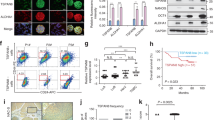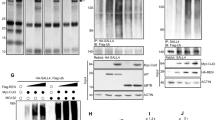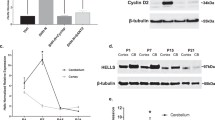Abstract
Bmi1 is a key stem cell regulatory gene implicated in the pathogenesis of many aggressive cancers, including medulloblastoma. Overexpression of Bmi1 promotes cell proliferation and is required for hedgehog (Hh) pathway-driven tumorigenesis. This study aimed to determine if Sonic hedgehog (Shh) modulates the key stem cell regulatory gene Bmi1 in childhood medulloblastoma brain tumor-initiating cells (BTICs). Although current literature suggests that there is a correlation between Shh pathway genes and Bmi1 expression, it is unclear whether there is indeed a direct regulatory mechanism. To address whether Shh induces expression of Bmi1, stem cell-enriched populations from medulloblastoma cell lines and primary samples were treated with Shh ligand and KAAD-cyclopamine (Shh antagonist). Our data indicate that Bmi1 expression positively correlates with increasing Shh ligand concentrations. Chromatin immunoprecipitation reveals that Gli1 preferentially binds to the Bmi1 promoter, and Bmi1 transcript levels are increased and decreased by Gli1 overexpression and downregulation, respectively. Knockdown experiments of Bmi1 in vitro and in vivo demonstrate that Hh signaling not only drives Bmi1 expression, but a feedback mechanism exists wherein downstream effectors of Bmi1 may, in turn, activate Hh pathway genes. These findings implicate Bmi1 and Hh as mutually indispensable pathways in medulloblastoma BTIC maintenance. Recent molecular characterization of medulloblastoma also reveals that Bmi1 is overexpressed across all subgroups of medulloblastoma, particularly in the most aggressive subtypes. Lastly, despite recent identification of BTIC markers, the molecular characterization of these cell populations remains unclear. In this work, we propose that the BTIC marker CD133 may segregate a cell population with a Hh-receptor phenotype, thus demonstrating a cell–cell interaction between the CD133+ Hh receptor cells and the CD133− Hh-secreting cells.
This is a preview of subscription content, access via your institution
Access options
Subscribe to this journal
Receive 50 print issues and online access
$259.00 per year
only $5.18 per issue
Buy this article
- Purchase on Springer Link
- Instant access to full article PDF
Prices may be subject to local taxes which are calculated during checkout





Similar content being viewed by others
References
Annabi B, Doumit J, Plouffe K, Laflamme C, Lord-Dufour S, Beliveau R . (2010). Members of the low-density lipoprotein receptor-related proteins provide a differential molecular signature between parental and CD133+ DAOY medulloblastoma cells. Mol Carcinog 49: 710–717.
Annabi B, Rojas-Sutterlin S, Laflamme C, Lachambre MP, Rolland Y, Sartelet H et al. (2008). Tumor environment dictates medulloblastoma cancer stem cell expression and invasive phenotype. Mol Cancer Res 6: 907–916.
Ayrault O, Zhao H, Zindy F, Qu C, Sherr CJ, Roussel MF . (2010). Atoh1 inhibits neuronal differentiation and collaborates with Gli1 to generate medulloblastoma-initiating cells. Cancer Res 70: 5618–5627.
Bao S, Wu Q, McLendon RE, Hao Y, Shi Q, Hjelmeland AB et al. (2006). Glioma stem cells promote radioresistance by preferential activation of the DNA damage response. Nature 444: 756–760.
Bendall SC, Stewart MH, Menendez P, George D, Vijayaragavan K, Werbowetski-Ogilvie T et al. (2007). IGF and FGF cooperatively establish the regulatory stem cell niche of pluripotent human cells in vitro. Nature 448: 1015–1021.
Berman DM, Karhadkar SS, Hallahan AR, Pritchard JI, Eberhart CG, Watkins DN et al. (2002). Medulloblastoma growth inhibition by hedgehog pathway blockade. Science 297: 1559–1561.
Blanpain C, Lowry WE, Geoghegan A, Polak L, Fuchs E . (2004). Self-renewal, multipotency, and the existence of two cell populations within an epithelial stem cell niche. Cell 118: 635–648.
Blazek ER, Foutch JL, Maki G . (2007). Daoy medulloblastoma cells that express CD133 are radioresistant relative to CD133− cells, and the CD133+ sector is enlarged by hypoxia. Int J Radiat Oncol Biol Phys 67: 1–5.
Bracken AP, Dietrich N, Pasini D, Hansen KH, Helin K . (2006). Genome-wide mapping of Polycomb target genes unravels their roles in cell fate transitions. Genes Dev 20: 1123–1136.
Bruggeman SW, Hulsman D, Tanger E, Buckle T, Blom M, Zevenhoven J et al. (2007). Bmi1 controls tumor development in an Ink4a/Arf-independent manner in a mouse model for glioma. Cancer Cell 12: 328–341.
Chen R, Nishimura MC, Bumbaca SM, Kharbanda S, Forrest WF, Kasman IM et al. (2010). A hierarchy of self-renewing tumor-initiating cell types in glioblastoma. Cancer Cell 17: 362–375.
Clement V, Sanchez P, de Tribolet N, Radovanovic I, Ruiz i Altaba A . (2007). HEDGEHOG-GLI1 signaling regulates human glioma growth, cancer stem cell self-renewal, and tumorigenicity. Curr Biol 17: 165–172.
Crawford JR, MacDonald TJ, Packer RJ . (2007). Medulloblastoma in childhood: new biological advances. Lancet Neurol 6: 1073–1085.
Dahl JA, Collas P . (2008). A rapid micro chromatin immunoprecipitation assay (microChIP). Nat Protoc 3: 1032–1045.
Dahmane N, Ruiz i Altaba A . (1999). Sonic hedgehog regulates the growth and patterning of the cerebellum. Development 126: 3089–3100.
Dahmane N, Sanchez P, Gitton Y, Palma V, Sun T, Beyna M et al. (2001). The Sonic Hedgehog-Gli pathway regulates dorsal brain growth and tumorigenesis. Development 128: 5201–5212.
Ellison DW . (2010). Childhood medulloblastoma: novel approaches to the classification of a heterogeneous disease. Acta Neuropathol 120: 305–316.
Ellison DW, Onilude OE, Lindsey JC, Lusher ME, Weston CL, Taylor RE et al. (2005). beta-Catenin status predicts a favorable outcome in childhood medulloblastoma: the United Kingdom Children's Cancer Study Group Brain Tumour Committee. J Clin Oncol 23: 7951–7957.
Fan X, Matsui W, Khaki L, Stearns D, Chun J, Li YM et al. (2006). Notch pathway inhibition depletes stem-like cells and blocks engraftment in embryonal brain tumors. Cancer Res 66: 7445–7452.
Fattet S, Haberler C, Legoix P, Varlet P, Lellouch-Tubiana A, Lair S et al. (2009). Beta-catenin status in paediatric medulloblastomas: correlation of immunohistochemical expression with mutational status, genetic profiles, and clinical characteristics. J Pathol 218: 86–94.
Flora A, Klisch TJ, Schuster G, Zoghbi HY . (2009). Deletion of Atoh1 disrupts Sonic Hedgehog signaling in the developing cerebellum and prevents medulloblastoma. Science 326: 1424–1427.
Fuccillo M, Joyner AL, Fishell G . (2006). Morphogen to mitogen: the multiple roles of hedgehog signalling in vertebrate neural development. Nat Rev Neurosci 7: 772–783.
Gibson P, Tong Y, Robinson G, Thompson MC, Currle DS, Eden C et al. (2010). Subtypes of medulloblastoma have distinct developmental origins. Nature 468: 1095–1099.
Gilbertson RJ . (2004). Medulloblastoma: signalling a change in treatment. Lancet Oncol 5: 209–218.
Gilbertson RJ, Ellison DW . (2008). The origins of medulloblastoma subtypes. Annu Rev Pathol 3: 341–365.
Glinsky GV, Berezovska O, Glinskii AB . (2005). Microarray analysis identifies a death-from-cancer signature predicting therapy failure in patients with multiple types of cancer. J Clin Invest 115: 1503–1521.
Hallahan AR, Pritchard JI, Hansen S, Benson M, Stoeck J, Hatton BA et al. (2004). The SmoA1 mouse model reveals that notch signaling is critical for the growth and survival of sonic hedgehog-induced medulloblastomas. Cancer Res 64: 7794–7800.
Huse JT, Holland EC . (2010). Targeting brain cancer: advances in the molecular pathology of malignant glioma and medulloblastoma. Nat Rev Cancer 10: 319–331.
Johnson R, Wright KD, Gilbertson RJ . (2009). Molecular profiling of pediatric brain tumors: insight into biology and treatment. Curr Oncol Rep 11: 68–72.
Kimura H, Stephen D, Joyner A, Curran T . (2005). Gli1 is important for medulloblastoma formation in Ptc1+/− mice. Oncogene 24: 4026–4036.
Kool M, Koster J, Bunt J, Hasselt NE, Lakeman A, van Sluis P et al. (2008). Integrated genomics identifies five medulloblastoma subtypes with distinct genetic profiles, pathway signatures and clinicopathological features. PLoS One 3: e3088.
Lee A, Kessler JD, Read TA, Kaiser C, Corbeil D, Huttner WB et al. (2005). Isolation of neural stem cells from the postnatal cerebellum. Nat Neurosci 8: 723–729.
Lee EY, Ji H, Ouyang Z, Zhou B, Ma W, Vokes SA et al. (2010). Hedgehog pathway-regulated gene networks in cerebellum development and tumorigenesis. Proc Natl Acad Sci USA 107: 9736–9741.
Leung C, Lingbeek M, Shakhova O, Liu J, Tanger E, Saremaslani P et al. (2004). Bmi1 is essential for cerebellar development and is overexpressed in human medulloblastomas. Nature 428: 337–341.
Liu S, Dontu G, Mantle ID, Patel S, Ahn NS, Jackson KW et al. (2006). Hedgehog signaling and Bmi-1 regulate self-renewal of normal and malignant human mammary stem cells. Cancer Res 66: 6063–6071.
Mao J, Ligon KL, Rakhlin EY, Thayer SP, Bronson RT, Rowitch D et al. (2006). A novel somatic mouse model to survey tumorigenic potential applied to the Hedgehog pathway. Cancer Res 66: 10171–10178.
McCord AM, Jamal M, Williams ES, Camphausen K, Tofilon PJ . (2009). CD133+ glioblastoma stem-like cells are radiosensitive with a defective DNA damage response compared with established cell lines. Clin Cancer Res 15: 5145–5153.
Michael LE, Westerman BA, Ermilov AN, Wang A, Ferris J, Liu J et al. (2008). Bmi1 is required for Hedgehog pathway-driven medulloblastoma expansion. Neoplasia 10: 1343–1349, 5p following 1349.
Northcott PA, Korshunov A, Witt H, Hielscher T, Eberhart CG, Mack S et al. (2010). Medulloblastoma comprises four distinct molecular variants. J Clin Oncol 29: 1408–1414.
Oliver TG, Grasfeder LL, Carroll AL, Kaiser C, Gillingham CL, Lin SM et al. (2003). Transcriptional profiling of the Sonic hedgehog response: a critical role for N-myc in proliferation of neuronal precursors. Proc Natl Acad Sci USA 100: 7331–7336.
Oliver TG, Read TA, Kessler JD, Mehmeti A, Wells JF, Huynh TT et al. (2005). Loss of patched and disruption of granule cell development in a pre-neoplastic stage of medulloblastoma. Development 132: 2425–2439.
Pallini R, Ricci-Vitiani L, Montano N, Mollinari C, Biffoni M, Cenci T et al. (2010). Expression of the stem cell marker CD133 in recurrent glioblastoma and its value for prognosis. Cancer 117: 162–174.
Parsons DW, Li M, Zhang X, Jones S, Leary RJ, Lin JC et al. (2010). The genetic landscape of the childhood cancer medulloblastoma. Science 331: 435–439.
Pistollato F, Rampazzo E, Persano L, Abbadi S, Frasson C, Denaro L et al. (2010). Interaction of hypoxia-inducible factor-1alpha and Notch signaling regulates medulloblastoma precursor proliferation and fate. Stem Cells 28: 1918–1929.
Pomeroy SL, Tamayo P, Gaasenbeek M, Sturla LM, Angelo M, McLaughlin ME et al. (2002). Prediction of central nervous system embryonal tumour outcome based on gene expression. Nature 415: 436–442.
Rao G, Pedone CA, Del Valle L, Reiss K, Holland EC, Fults DW . (2004). Sonic hedgehog and insulin-like growth factor signaling synergize to induce medulloblastoma formation from nestin-expressing neural progenitors in mice. Oncogene 23: 6156–6162.
Read TA, Fogarty MP, Markant SL, McLendon RE, Wei Z, Ellison DW et al. (2009). Identification of CD15 as a marker for tumor-propagating cells in a mouse model of medulloblastoma. Cancer Cell 15: 135–147.
Romer JT, Kimura H, Magdaleno S, Sasai K, Fuller C, Baines H et al. (2004). Suppression of the Shh pathway using a small molecule inhibitor eliminates medulloblastoma in Ptc1(+/−)p53(−7sol;−) mice. Cancer Cell 6: 229–240.
Ruiz i Altaba A, Palma V, Dahmane N . (2002). Hedgehog-Gli signalling and the growth of the brain. Nat Rev Neurosci 3: 24–33.
Schuller U, Heine VM, Mao J, Kho AT, Dillon AK, Han YG et al. (2008). Acquisition of granule neuron precursor identity is a critical determinant of progenitor cell competence to form Shh-induced medulloblastoma. Cancer Cell 14: 123–134.
Singh SK, Clarke ID, Terasaki M, Bonn VE, Hawkins C, Squire J et al. (2003). Identification of a cancer stem cell in human brain tumors. Cancer Res 63: 5821–5828.
Singh SK, Hawkins C, Clarke ID, Squire JA, Bayani J, Hide T et al. (2004). Identification of human brain tumour initiating cells. Nature 432: 396–401.
Subkhankulova T, Zhang X, Leung C, Marino S . (2010). Bmi1 directly represses p21Waf1/Cip1 in Shh-induced proliferation of cerebellar granule cell progenitors. Mol Cell Neurosci 45: 151–162.
Sutter R, Shakhova O, Bhagat H, Behesti H, Sutter C, Penkar S et al. (2010). Cerebellar stem cells act as medulloblastoma-initiating cells in a mouse model and a neural stem cell signature characterizes a subset of human medulloblastomas. Oncogene 29: 1845–1856.
Taylor MD, Liu L, Raffel C, Hui CC, Mainprize TG, Zhang X et al. (2002). Mutations in SUFU predispose to medulloblastoma. Nat Genet 31: 306–310.
Thomas WD, Chen J, Gao YR, Cheung B, Koach J, Sekyere E et al. (2009). Patched1 deletion increases N-Myc protein stability as a mechanism of medulloblastoma initiation and progression. Oncogene 28: 1605–1615.
Thompson MC, Fuller C, Hogg TL, Dalton J, Finkelstein D, Lau CC et al. (2006). Genomics identifies medulloblastoma subgroups that are enriched for specific genetic alterations. J Clin Oncol 24: 1924–1931.
Thon N, Damianoff K, Hegermann J, Grau S, Krebs B, Schnell O et al. (2008). Presence of pluripotent CD133(+) cells correlates with malignancy of gliomas. Mol Cell Neurosci 43: 51–59.
Uchida N, Buck DW, He D, Reitsma MJ, Masek M, Phan TV et al. (2000). Direct isolation of human central nervous system stem cells. Proc Natl Acad Sci USA 97: 14720–14725.
Valk-Lingbeek ME, Bruggeman SW, van Lohuizen M . (2004). Stem cells and cancer; the polycomb connection. Cell 118: 409–418.
Wang R, Chadalavada K, Wilshire J, Kowalik U, Hovinga KE, Geber A et al. (2010). Glioblastoma stem-like cells give rise to tumour endothelium. Nature 468: 829–833.
Wechsler-Reya RJ, Scott MP . (1999). Control of neuronal precursor proliferation in the cerebellum by Sonic Hedgehog. Neuron 22: 103–114.
Wiederschain D, Chen L, Johnson B, Bettano K, Jackson D, Taraszka J et al. (2007). Contribution of polycomb homologues Bmi-1 and Mel-18 to medulloblastoma pathogenesis. Mol Cell Biol 27: 4968–4979.
Yan X, Ma L, Yi D, Yoon JG, Diercks A, Foltz G et al. (2011). A CD133-related gene expression signature identifies an aggressive glioblastoma subtype with excessive mutations. Proc Natl Acad Sci USA 108: 1591–1596.
Yang MH, Hsu DS, Wang HW, Wang HJ, Lan HY, Yang WH et al. (2010). Bmi1 is essential in Twist1-induced epithelial-mesenchymal transition. Nat Cell Biol 12: 982–992.
Yang ZJ, Ellis T, Markant SL, Read TA, Kessler JD, Bourboulas M et al. (2008). Medulloblastoma can be initiated by deletion of Patched in lineage-restricted progenitors or stem cells. Cancer Cell 14: 135–145.
Yin AH, Miraglia S, Zanjani ED, Almeida-Porada G, Ogawa M, Leary AG et al. (1997). AC133, a novel marker for human hematopoietic stem and progenitor cells. Blood 90: 5002–5012.
Yu CC, Chiou GY, Lee YY, Chang YL, Huang PI, Cheng YW et al. (2010). Medulloblastoma-derived tumor stem-like cells acquired resistance to TRAIL-induced apoptosis and radiosensitivity. Childs Nerv Syst 26: 897–904.
Zakrzewska M, Zakrzewski K, Gresner SM, Piaskowski S, Zalewska-Szewczyk B, Liberski PP . (2011). Polycomb genes expression as a predictor of poor clinical outcome in children with medulloblastoma. Childs Nerv Syst 27: 79–86.
Acknowledgements
We are very grateful to Atsushi Iwama for kind provision of Bmi1 shRNA lentiviral construct. We thank Merry Wang for artistic illustrations. This work was supported by funds from the Department of Surgery at McMaster University, the Ontario Institute for Cancer Research (OICR) and the JP Bickell Foundation. XW held a training award from the Stem Cell Network.
Author information
Authors and Affiliations
Corresponding author
Ethics declarations
Competing interests
The authors declare no conflict of interest.
Additional information
Supplementary Information accompanies the paper on the Oncogene website
Rights and permissions
About this article
Cite this article
Wang, X., Venugopal, C., Manoranjan, B. et al. Sonic hedgehog regulates Bmi1 in human medulloblastoma brain tumor-initiating cells. Oncogene 31, 187–199 (2012). https://doi.org/10.1038/onc.2011.232
Received:
Revised:
Accepted:
Published:
Issue Date:
DOI: https://doi.org/10.1038/onc.2011.232
Keywords
This article is cited by
-
Mechanisms of vasculogenic mimicry in hypoxic tumor microenvironments
Molecular Cancer (2021)
-
A novel protein encoded by circular SMO RNA is essential for Hedgehog signaling activation and glioblastoma tumorigenicity
Genome Biology (2021)
-
Exploring Sonic Hedgehog Cell Signaling in Neurogenesis: Its Potential Role in Depressive Behavior
Neurochemical Research (2021)
-
DHHC protein family targets different subsets of glioma stem cells in specific niches
Journal of Experimental & Clinical Cancer Research (2019)
-
Attenuation of hedgehog/GLI signaling by NT1721 extends survival in pancreatic cancer
Journal of Experimental & Clinical Cancer Research (2019)



